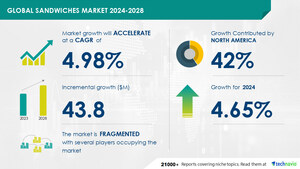NEW YORK, June 21, 2024 /PRNewswire/ -- The global dry eye syndrome drugs market size is estimated to grow by USD 2.13 billion from 2024-2028, according to Technavio. The market is estimated to grow at a CAGR of almost 6.16% during the forecast period. Growing geriatric population is driving market growth, with a trend towards advancements in drug delivery technologies. However, less visibility into reimbursement of ophthalmic disorder treatments poses a challenge. Key market players include Abbott Laboratories, AbbVie Inc., AFT Pharmaceuticals Ltd., Akorn Operating Co LLC, Bausch Health Companies Inc., F. Hoffmann La Roche Ltd., GlaxoSmithKline Plc, I MED Pharma Inc., Johnson and Johnson Services Inc., Laboratoires Thea, Mitotech SA, Novaliq GmbH, Novartis AG, Oasis Medical Inc., Otsuka Holdings Co. Ltd., Santen Pharmaceutical Co. Ltd., Sentiss Pharma Pvt. Ltd., Sun Pharmaceutical Industries Ltd., Viatris Inc., and Visufarma.
Get a detailed analysis on regions, market segments, customer landscape, and companies- View the snapshot of this report
Dry Eye Syndrome Drugs Market Scope |
|
Report Coverage |
Details |
Base year |
2023 |
Historic period |
2018 - 2022 |
Forecast period |
2024-2028 |
Growth momentum & CAGR |
Accelerate at a CAGR of 6.16% |
Market growth 2024-2028 |
USD 2136.2 million |
Market structure |
Fragmented |
YoY growth 2022-2023 (%) |
5.71 |
Regional analysis |
North America, Europe, Asia, and Rest of World (ROW) |
Performing market contribution |
North America at 39% |
Key countries |
US, UK, Japan, Germany, and China |
Key companies profiled |
Abbott Laboratories, AbbVie Inc., AFT Pharmaceuticals Ltd., Akorn Operating Co LLC, Bausch Health Companies Inc., F. Hoffmann La Roche Ltd., GlaxoSmithKline Plc, I MED Pharma Inc., Johnson and Johnson Services Inc., Laboratoires Thea, Mitotech SA, Novaliq GmbH, Novartis AG, Oasis Medical Inc., Otsuka Holdings Co. Ltd., Santen Pharmaceutical Co. Ltd., Sentiss Pharma Pvt. Ltd., Sun Pharmaceutical Industries Ltd., Viatris Inc., and Visufarma |
Market Driver
Dry eye syndrome drugs market is witnessing significant growth due to advancements in drug delivery technologies. These innovations include lipid-based formulations that mimic natural tears, sustained release systems for controlled drug delivery, and nanotechnology-based approaches for targeted drug delivery. These advancements offer improved therapeutic outcomes, increased patient comfort, and enhanced treatment adherence, addressing challenges of traditional eye drops such as low bioavailability, poor patient compliance, and inconsistent dosing.
The Dry Eye Syndrome market is witnessing significant growth due to the increasing prevalence of this condition. Patients are seeking treatment for symptoms such as dryness, discomfort, and vision problems. Drugs like Cyclosporine, Dysfunctional Tear Syndrome, and Relevas are gaining popularity. These drugs work by increasing tear production and reducing evaporation. Prescription drugs like Restasis, Xiidra, and Systane Irrigation are commonly used. The market is driven by factors like an aging population, increasing awareness, and technological advancements in drug development. The future looks promising with new treatments like Autupline and Marketechs in the pipeline. The market is competitive with major players investing in research and development to offer effective solutions to patients.
Research report provides comprehensive data on impact of trend. For more details- Download a Sample Report
Market Challenges
- The Dry Eye Syndrome Drugs Market faces challenges due to limited visibility into reimbursements for treatments, particularly in developed countries like the US. High insurance costs and out-of-pocket expenses remain concerns. In developing economies such as India and China, a large population lacks health insurance coverage, making optimal treatment unaffordable. Administrative burdens and declining reimbursements due to government regulations hinder market growth during the forecast period.
- The Dry Eye Syndrome market faces several challenges in the development and implementation of effective drugs. Clinics and research centers are focusing on new approaches, such as hormonal treatments and artificial tears. However, the high cost of these treatments and the challenge of creating long-term solutions remain. Additionally, the need for continuous use of these drugs and potential side effects, like blurred vision and dryness, are concerns. The market also faces regulatory hurdles, as drugs must undergo rigorous testing and approval processes. Despite these challenges, companies are investing in research and development to address the unmet needs of patients with Dry Eye Syndrome.
For more insights on driver and challenges - Request a sample report!
Segment Overview
This dry eye syndrome drugs market report extensively covers market segmentation by
- Distribution Channel
- 1.1 Retail pharmacies
- 1.2 Hospital pharmacies
- 1.3 Online pharmacies
- Product
- 2.1 OTC drugs
- 2.2 Prescription drugs
- Geography
- 3.1 North America
- 3.2 Europe
- 3.3 Asia
- 3.4 Rest of World (ROW)
1.1 Retail pharmacies- Retail pharmacies are essential in distributing dry eye syndrome drugs to consumers, providing easy access to over-the-counter and prescription medications. These pharmacies, including independents, chains, and drugstore retailers, stock a wide variety of dry eye treatments, such as artificial tears, ointments, and gels. Pharmacists offer guidance on medication selection and usage, catering to patients' preferences for in-person assistance and personalized recommendations. The retail pharmacy segment significantly contributes to the global dry eye syndrome drugs market by ensuring accessibility and convenience for patients.
For more information on market segmentation with geographical analysis including forecast (2024-2028) and historic data (2017-2021) - Download a Sample Report
Research Analysis
The Dry Eye Syndrome Drugs Market encompasses a range of therapeutic options for managing Dry Eye Disease (DED), a common condition characterized by tear film instability, inflammation, and ocular discomfort. Autoimmune disorders, hormonal changes, and the geriatric population are significant contributors to the prevalence of DED. Ophthalmologists and optometrists in Eye Care Centers and private practices provide clinical care for patients, utilizing various treatments such as CEQUA therapy drug, nanodroplet technology, and contact lenses. Alternative therapies, including nutritional supplements and acupuncture, also play a role in managing DED symptoms. Drug manufacturers are continually developing new drugs and regulatory procedures to ensure drug approval through clinical trials. Conditions like diabetes and rheumatic diseases can exacerbate DED, further increasing the demand for effective treatments. Blood composition imbalances may also contribute to DED, necessitating ongoing research and innovation in the Dry Eye Syndrome Drugs Market.
Market Research Overview
The Dry Eye Syndrome Drugs Market encompasses a range of treatments designed to manage and alleviate the symptoms of dry eye disease. These therapies include artificial tears, ointments, gels, and prescription medications. The market for these drugs is driven by the increasing prevalence of dry eye syndrome, particularly in aging populations and those with certain health conditions. Commonly used drugs include cyclosporine, lifitegrast, and pilocarpine. The market is also witnessing the development of novel therapies, such as autologous serum eye drops and scleral lenses, which offer alternative treatment options for patients. Additionally, the market is influenced by regulatory approvals, pricing strategies, and competition among various drug classes.
Table of Contents:
1 Executive Summary
2 Market Landscape
3 Market Sizing
4 Historic Market Size
5 Five Forces Analysis
6 Market Segmentation
- Distribution Channel
- Retail Pharmacies
- Hospital Pharmacies
- Online Pharmacies
- Product
- OTC Drugs
- Prescription Drugs
- Geography
- North America
- Europe
- Asia
- Rest Of World (ROW)
7 Customer Landscape
8 Geographic Landscape
9 Drivers, Challenges, and Trends
10 Company Landscape
11 Company Analysis
12 Appendix
About Technavio
Technavio is a leading global technology research and advisory company. Their research and analysis focuses on emerging market trends and provides actionable insights to help businesses identify market opportunities and develop effective strategies to optimize their market positions.
With over 500 specialized analysts, Technavio's report library consists of more than 17,000 reports and counting, covering 800 technologies, spanning across 50 countries. Their client base consists of enterprises of all sizes, including more than 100 Fortune 500 companies. This growing client base relies on Technavio's comprehensive coverage, extensive research, and actionable market insights to identify opportunities in existing and potential markets and assess their competitive positions within changing market scenarios.
Contacts
Technavio Research
Jesse Maida
Media & Marketing Executive
US: +1 844 364 1100
UK: +44 203 893 3200
Email: [email protected]
Website: www.technavio.com/
SOURCE Technavio

WANT YOUR COMPANY'S NEWS FEATURED ON PRNEWSWIRE.COM?
Newsrooms &
Influencers
Digital Media
Outlets
Journalists
Opted In





Share this article